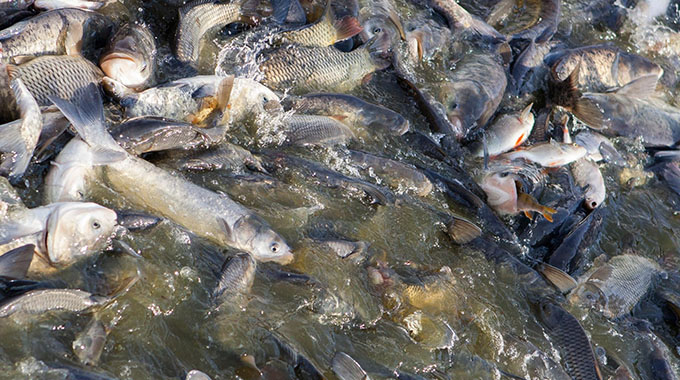Hidden opportunities for aquaculture

The Poverty, Income, Consumption and Expenditure Survey undertaken by the Zimbabwe National Statistics Agency (ZimSTATS) in 2017 was released recently and the report provides the best evidence of the level of fish consumption in Zimbabwe.
The estimated total annual fish consumption in 2017 was 50 497 tonnes with a commercial retail market value of US$132 million.
In contrast, the Livestock and Meat Advisory Council estimates that the country consumes about 120 000 tonnes of broiler chicken meat, 72 000 tonnes of beef and 9 250 tonnes of pork each year, making fish the third most consumed meat product in Zimbabwe.
The annual per capita consumption of fresh, frozen and dried fish is 3,89kg and 3,64kg in rural and urban areas, respectively, and an average national annual per capita consumption of 3,72kg.
According to the survey, the rural population accounts for 68 percent of annual fish consumption in both volume and value while the urban community accounts for 32 percentage of the annual expenditure on fish consumption.
In contrast, the rural population accounts for 35, 41 and 26 percent, respectively of poultry, beef and pork products consumed in Zimbabwe. Fish is therefore a relatively more accessible protein product for the rural populace.
Zimbabwe has committed itself to the United Nations 2030 Agenda for Sustainable Development and its 17 goals (SDGs). Nutrition is a key pillar under the SDGs. For example, SDG 2 is to “End hunger, achieve food security and improved nutrition and promote sustainable agriculture”. In addition, at least 12 of the 17 Goals contain indicators that are highly relevant to nutrition.
Protein consumption is critical for the achievement of Zimbabwe’s nutrition goals.
Despite showing marked improvement in the prevalence of stunting in children less than five years of age from 34 percent in 2010 to 26 percent in 2018, there are significant disparities in these indicators among rural and urban areas and among rich and poor households.
According to recent nutrition surveys, stunting levels are higher in rural areas at 29 percent compared to 22 percent in urban areas. Increasing fish consumption by rural and poor urban households can contribute to reducing stunting. Stunting is linked to poor brain development in children.
However, the demand for fish in Zimbabwe is very low compared to other countries in the region. Close to home, the annual per capita fish consumption in South Africa and Zambia is 15,4kg and 6,5kg respectively which dwarf Zimbabwe’s per capita consumption.
Zimbabwe needs to double its consumption to match or exceed its close neighbours.
The current source of fish consumption is non-sustainable as most of this fish is either imported or from capture fisheries. The major fish products consumed in Zimbabwe are fresh and frozen bream, frozen mackerel and dried kapenta, which account for 27, 28 and 26 percent of total fish consumed, respectively. All the mackerel is imported from Namibia while some kapenta is imported from Cabora Bassa Dam in Mozambique. Based on ZimSTATS trade data, Zimbabwe on average, imported 9 482tof fish per annum between 2017 and 2020.
These imports cost the country US$10,2 million per annum in lost foreign currency.
In addition, all the kapenta and the bulk of bream consumed in Zimbabwe is from capture fisheries. Zimbabwe Parks and Wildlife Management Authority has been raising the alarm about overfishing in Zimbabwe’s water bodies which has led to dwindling natural fish stocks during the past few years.
To reduce the country’s fish import bill and ensure sustainable growth in fish output and consumption, the Zimbabwe Fish Producers’ Association (ZFPA) has been promoting fish production. ZFPA was established in March 2016 to promote and develop fisheries and aquaculture as a fully-fledged and vibrant part of the livestock industry.
Four years on, much has been done to create a framework to build a vibrant and viable fish farming industry with strong value chains that incorporate small-scale and commercial fish farmers.
With more than 10 000 inland dams on its network of river basins, Zimbabwe has tremendous potential for increasing commercial production of fish for domestic consumption and export markets.
Despite the massive investment in dams, the fish farming sector has remained grossly underdeveloped, poorly coordinated at policy level and under-reported in national agricultural and food security statistics. According to Mr Garikayi Munatsirei, the current Chairman of ZFPA, ‘Fish farming is a non-consumptive use of water currently harnessed for irrigation in the farming sector.
Farmers with water bodies are able to earn extra income from a fish enterprise without compromising their irrigated crop production. With an enabling policy environment, there is potential to double fish production in Zimbabwe over the next five years.
The Zimbabwe Fish Producers Association therefore welcomes the recent incorporation of fisheries and aquatic resources under the Ministry of Lands, Agriculture, Water, Fisheries and Rural Resettlement as a first step in providing such an enabling policy framework.
The association stands ready to work hand in hand with the new Department of Fisheries and Aquatic Resources to craft strategies for the inclusive and sustainable growth of fish farming in Zimbabwe.’
Aquaculture in Zimbabwe is at an exciting confluence, with developments in the fish industry coming together propitiously.
This augurs well for the expansion of fish farming, especially with the focus on small-scale production leveraging on advances already made by the pioneering investments in aquaculture by established stakeholders.







